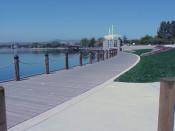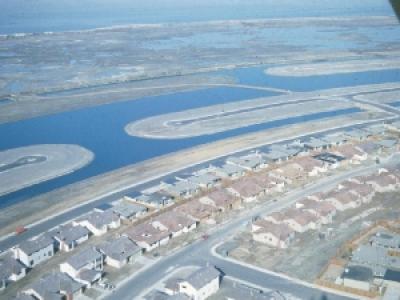The Creation of Foster City - Built
Built to Withstand a "100 Year Flood"
The scope of the engineering concept that created the land that Foster City sits on was truly dramatic. 2.5 million yards of material were excavated to create the lagoon (impoundment basin).
The lagoon is 218 surface acres, containing 425 million gallons of water. There are 16.5 miles of drainage channels, and four traffic bridges span the lagoon. For water inflow, three automatic gates bring in up to 71 million gallons per day from the Bay. In the rainy season (from November through February) four 66-inch diameter pipes, two of which are connected to two massive 700 horsepower diesel motors, can expel an amazing maximum of 250/000 gallons of water from the lagoon to the Bay every minute!
In all, the City's lagoon drainage system was designed to withstand a storm of "100 year return frequency" (that is, a storm of such severity that it has only a one percent probability of occurring each century) and it works extremely well. During the devastating storms of 1982, which were very close to a 100 year frequency severity, the City of Foster City experienced no flooding, while surrounding cities in San Mateo County experienced major drainage problems. From the time the impoundment area was constructed to the present day, Foster City has never experienced draining flooding.

The EMID is Born
Created in 1960, the Estero Municipal Improvement District became a self-governing entity with a Board of Directors. The three original members of this Board were elected on the basis of "one vote per one dollar of assessed valuation" of land in the District. In other words, the more land owned, the larger the voting power, which consequently gave Foster complete sway in running the district (such an arrangement was necessary because the "City" had no residents at the time).
The District provided the developers the "unlimited ability" to sell bonds to finance the infrastructure development of Foster City. The bonds were to be paid back through the levying of assessments on property based upon future development; a method of raising revenue otherwise known as the "Zones of Benefit" method of taxation. In Article 10.5 of the Estero Municipal Improvement Act, the Zones of Benefit method is explained as "....the District may be divided into zone or zones according to such benefits" received, allowing revenues to thus "be levied and collected upon the taxable property within each zone in accordance with the percentage of the sum to be raised each year in such zone by the levy and collection of said tax."
